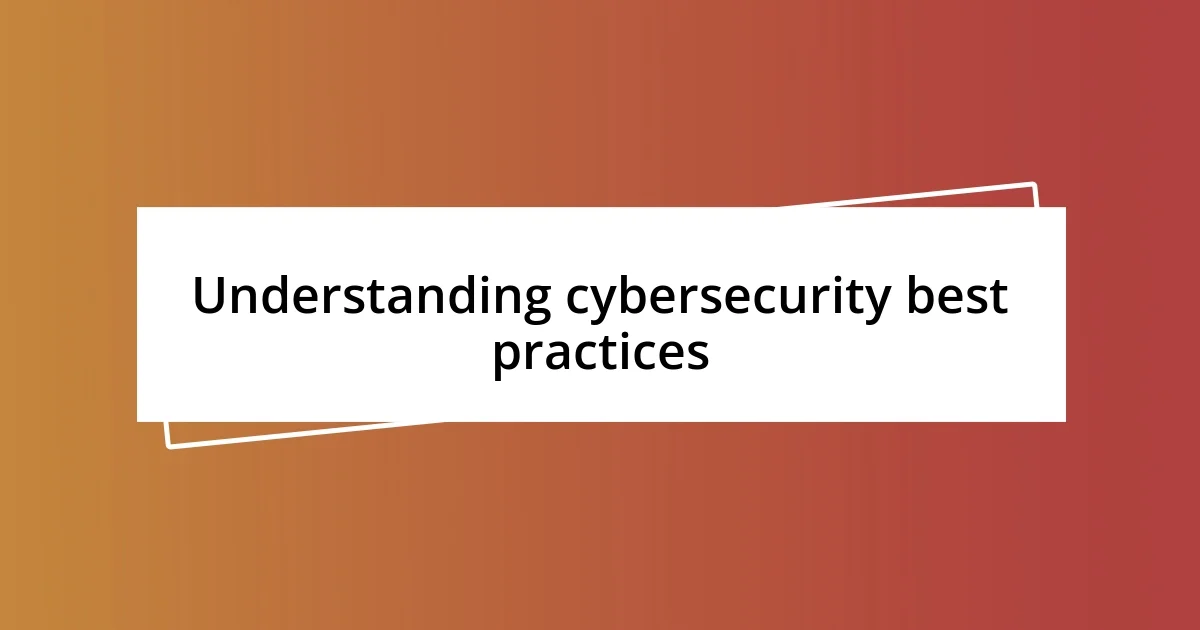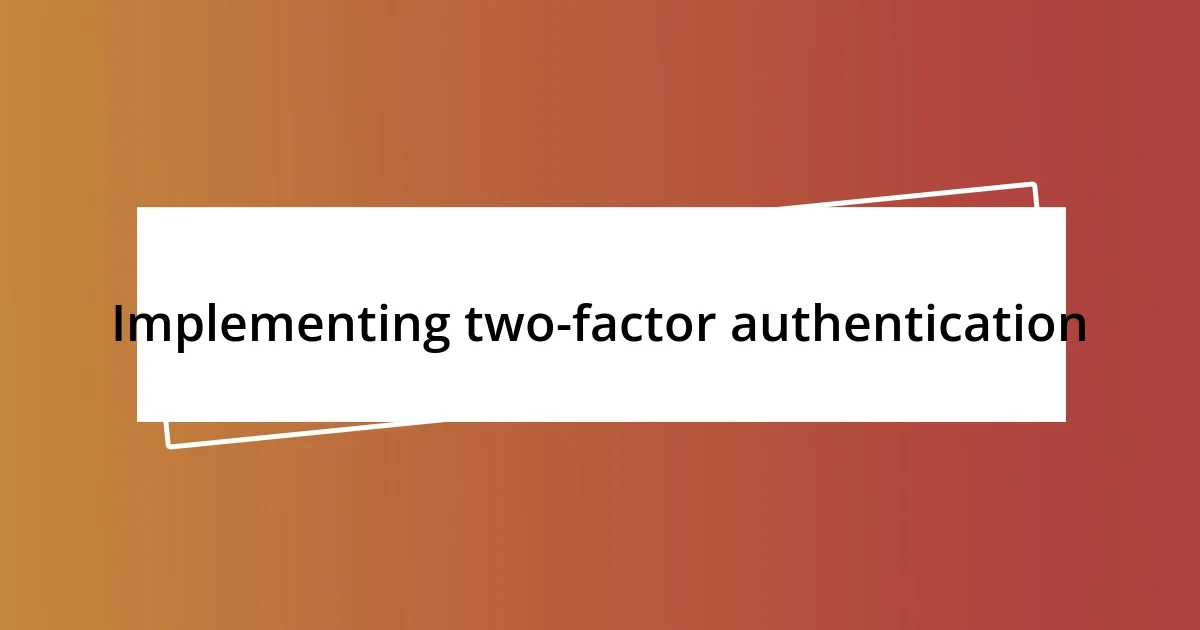Key takeaways:
- Regular software updates and patches are crucial for cybersecurity; neglecting them can lead to vulnerabilities and data loss.
- Strong passwords and two-factor authentication (2FA) significantly enhance online security, acting as essential defenses against unauthorized access.
- Developing and maintaining an incident response plan, involving multiple departments, ensures preparedness for cyber threats and facilitates effective responses during crises.

Understanding cybersecurity best practices
Understanding cybersecurity best practices requires a combination of awareness, vigilance, and proactive measures. I often wonder, do we really grasp the importance of a strong password? I remember when I was prompted to change a simple password that I had used for years; it felt like a hassle, but the peace of mind that followed was invaluable.
One of the core best practices is regular software updates. I’ve seen firsthand how neglecting these updates can lead to vulnerabilities. Just last year, a friend of mine ignored a critical update on their device, and it cost them dearly when a malware attack compromised their personal information.
Another essential practice is backing up data regularly. I recall a time when my computer crashed unexpectedly, and I lost months of work. After that experience, I made it a habit to back up my data in multiple locations. It’s a simple step, but it can save you from a potentially devastating situation. Isn’t it wild how a few minutes can protect hours of hard work?

Importance of strong passwords
Strong passwords are the foundation of online security. I vividly remember a time when I received an email alert about an unauthorized login attempt on one of my accounts. That heart-stopping moment made me realize how easily a weak password could lead to a data breach. The truth is, a strong password acts as your first line of defense against cyber threats.
To create an effective password, consider these best practices:
– Use at least 12 characters, combining upper and lowercase letters, numbers, and symbols.
– Avoid using easily guessable information like birthdays or names.
– Change your passwords regularly, especially if you suspect a breach.
– Don’t reuse passwords across different accounts; each account deserves its own protection.
– Utilize a password manager to store and generate complex passwords securely.
By being mindful of these practices, you can significantly reduce your vulnerability to cyberattacks. It’s often the little things that offer the greatest security, and I’ve found that taking these steps brings a sense of control and safety that’s incredibly reassuring.

Implementing two-factor authentication
Implementing two-factor authentication (2FA) is one of the most effective ways to enhance your online security. I remember the first time I set up 2FA on my accounts. It felt like adding a second lock to my front door; a small extra step that made my data feel so much safer. Just knowing that even if someone cracked my password, they’d need that second factor to access my account was such a relief.
There are various forms of two-factor authentication, such as SMS codes, authentication apps, or hardware tokens. From my experience, using an app like Google Authenticator is a game-changer. The codes are generated right on my phone, adding a layer of security that I can count on. I often ask myself, why risk it? The added security of 2FA makes it really hard for intruders to breach my accounts.
However, it’s essential to consider the usability side of 2FA, too. At times, I’ve found myself frustrated when I was in a hurry and had to wait for a code to arrive via SMS. It’s a balance between security and convenience. In the end, the peace of mind that comes from knowing I’ve taken a vital step towards protecting my personal information outweighs that minor inconvenience.
| Two-Factor Authentication Methods | Pros and Cons |
|---|---|
| SMS Codes | Pros: Easy to set up; Cons: Vulnerable to SIM swapping |
| Authentication Apps | Pros: More secure; Cons: Requires a smartphone |
| Hardware Tokens | Pros: Very secure; Cons: Easy to lose or misplace |

Regular software updates and patches
Keeping software updated is crucial for maintaining cybersecurity, and I can’t stress this enough. There have been times when I delayed updating my applications, thinking it was just a minor inconvenience. Who would have thought that a simple oversight could open the door to vulnerabilities? Regularly checking for updates is like giving your system a protective shield; it helps patch known security gaps that hackers exploit.
I remember a specific instance when a friend’s computer was infected because they neglected an important software update. It was hard watching them scramble to recover lost data, knowing that the update was rolled out just a few days earlier. This experience reinforced my belief that dedicating a few minutes each month to install updates can save you from a lot of future headaches. Wouldn’t you rather spend that time now than deal with a full-blown security breach later?
Furthermore, I’ve come to see the value in enabling automatic updates for my devices. This way, I avoid the temptation to delay. The initial setup took mere minutes, yet it has given me peace of mind knowing my system is consistently fortified against the latest threats. For me, that’s a smart investment in my online safety. How about you? Have you considered how regular updates can shape your cybersecurity posture?

Educating employees on security awareness
Educating employees on cybersecurity awareness requires a thoughtful approach. I remember conducting my first security training session at work; it opened my eyes to how much even a few simple reminders can improve vigilance. Employees often feel overwhelmed or think security is someone else’s job. But I’ve found that by creating an engaging and interactive environment, like using real scenarios or gamifying the training, participants become more invested in their own security.
Regular refresher courses are also essential. At my previous job, we held quarterly workshops that not only updated everyone on the latest threats but also reinforced best practices. I’ll never forget the time one of my colleagues shared how an email phishing simulation made them realize their own vulnerabilities. That sense of shared learning and growth is invaluable. Don’t you think it’s vital to cultivate a culture where employees feel empowered to act against cyber threats?
Creating a safe space for discussing security issues can significantly boost employee awareness. I’ve often encouraged my team to voice their concerns or questions regarding security practices. When someone asked about the security of using personal devices for work, it started an engaging dialogue that made everyone rethink their habits. In my experience, fostering open communication around cybersecurity strengthens an organization’s defenses, as employees know they are not alone in this journey.

Monitoring and responding to threats
When it comes to monitoring threats, I’ve learned that the key is constant vigilance. I once set up alerts for unusual activity on my online accounts, and I was startled when one alert notified me about a login attempt from an unfamiliar location. That moment made me realize how essential it is to have a system in place to monitor unusual behavior; it allows for quick responses, potentially preventing a larger incident. Have you considered what might happen if you miss such early warnings?
A robust incident response plan is something I view as non-negotiable. At my last job, we developed a comprehensive framework that outlined how to respond to various types of cyber incidents. During a simulated attack, we practiced these protocols, which made a profound difference when we faced a real threat days later. Implementing a well-documented plan alleviated panic and gave everyone clear steps to follow. What’s your approach to having a contingency plan in place?
Engaging with tools such as intrusion detection systems (IDS) has become a game-changer for me. I remember the relief I felt seeing real-time feedback from the IDS notifying me of potential vulnerabilities. It’s like having a vigilant companion by my side, always ready to alert me. Such systems not only enhance awareness but also allow me to take immediate action to safeguard sensitive information. Isn’t it reassuring to think that technology can work alongside us in the fight against cyber threats?

Developing an incident response plan
Developing an incident response plan feels like preparing for a storm—you hope it never hits, but when it does, you want to be ready. At one point in my career, we faced an unexpected breach that put our systems at risk. Thankfully, our well-rehearsed incident response plan kicked in, guiding our team through each step with clear roles and responsibilities. It’s incredible how a structured approach can ease tension during such chaotic moments, isn’t it?
One of the most insightful lessons I’ve learned is the importance of involving various departments in the planning process. When my team collaborated with IT and legal to draft our incident response plan, it became a richer, more effective document. We ran through hypothetical scenarios, and I vividly recall the debate over how to handle different types of data breaches. Engaging different perspectives not only sharpened our tactics but also fostered a shared sense of ownership among the teams. Don’t you think that a collaborative effort makes a plan more robust?
I also believe that the plan should be a living document, updated regularly to reflect new threats and lessons learned. I’ve experienced the frustration of outdated procedures during a crisis, and it’s a feeling I’d prefer to avoid. For instance, after a team member faced a phishing attack, we quickly revised our procedures to include preventive measures and training. Maintaining flexibility in your plan helps ensure you’re not just prepared for today’s threats but future ones too. How often do you review your strategies?














